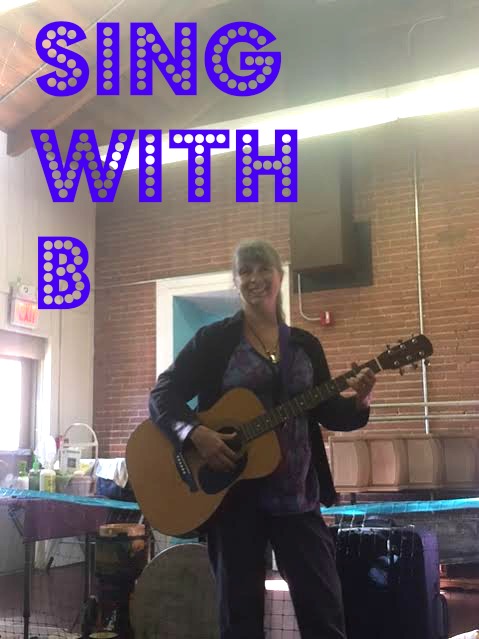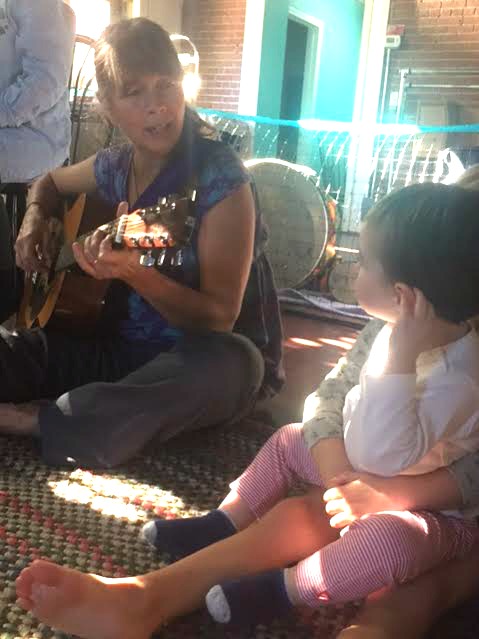*I received compensation for posting but I love Barbi’s classes and very happy to share. *
7 years ago when Hayley was only an itty bitty baby, I signed up for my first Sing with B class which is part of the Music Together cumulative curriculum. I vividly remember being slightly nervous to attend as I knew not one of the moms and didn’t know what the class would entail. Well, we had such an amazing experience that first year, that I proceeded to go to Barbi’s classes on and off for the past SEVEN years!
Last week, my youngest, Taylor (age 1), and I attended our first Sing with B class together. It was the flute collection which I was well used to since the CD constantly plays in our car. When we sat down, Barbi started with the hello song that introduced all the kids in a cute and lovely song. It was a welcoming song that not only welcomed the babies and kids, but also welcomed the parents and caretakers. In this day and age, there is a lot of babysitters and grandparents bringing their children to Music Together because more parents are back in the working field.
Barbi makes each and every class warming and allows the kids to basically run the class. She has a song and musical instrument, for the kids to play with, with each and every song. The children are allowed to move freely so parents don’t’ have to constantly chase them. The beauty of being in this class is you don’t have to keep reprimanding your kids for getting up- kids are welcome and encouraged to move around!
The class was very similar to the one that I did with Hayley seven years ago. Since it was an outstanding class back then, there was really nothing to change with the dynamics or the way the class runs. It was exciting to be able to remember almost every single song we sang that day from back when Hayley was a baby. The songs stick with you in the best way possible.
The class usually runs around 45 minutes and Barbi has a full schedule to accommodate as many children as she can. While classes do still have availability, it is best to sign up at the start of class semester to assure a spot as early as possible. Barbi is a warm, kind, and talented instructor that will have kids wanting to keep singing all day long!
Here is some more information from Barbi:
What can I expect from class?
Music Together is designed for children ages birth through kindergarten. In Music Together we believe that music ability is as much a basic life skill as walking and talking, and that all children can learn to sing in tune, keep a beat, and participate with pleasure and confidence in the music of their culture. Music Together classes nurture the child’s natural enthusiasm for music and movement as we sing, dance, chant, and play instruments in an informal setting that will enrich her musical environment and guide him/her towards a lifetime of music-making enjoyment.
Why aren’t there separate classes for different age groups?
In the 1980’s Music Together pioneered the development of the mixed-age approach in early childhood music. In each class we strive to create a musically rich, developmentally appropriate environment where the whole family can enjoy music and nurture skills at the level right for each child. Mixed-age classes also provide a rich learning environment because children of different ages thrive when they interact with each other: the babies are often fascinated by the older child, and the “big” children enjoy helping and sharing with the “little” ones.
What should I expect of myself?
Some parents are somewhat disconcerted by the concept of being their child’s most important role model, especially when it comes to music! You may feel that you are not particularly musical – perhaps you even describe yourself as being “tone deaf”. You may be great at singing but feel unsure of yourself or “vague” when dancing or trying to “keep the beat”. Whatever the level of your technical skill, remember the most important things you can model for your child are simply pleasure, interest, and the desire to participate in music activities.
Many adults feel deprived, confused, or inadequate about their ability in music, as if they have been denied something that should be effortless and natural. As your understanding of your child’s music development grows in the coming weeks, you may also come to understand that the circumstances in your own childhood music experience may be at the root of some of these feelings. More importantly, by participating with your child, you can begin to rediscover within yourself the natural human musicality that is everyone’s birthright.
What about practicing at home?
Play your Music Together CD at home or feel free to put it on your MP3 or Ipod (however you get your music!) It is also great to play the song collection while driving about. Do not limit its use to the car, though – children are less able to move to the music while strapped into a car seat!
Many children will want specific songs repeated again and again. Try to accommodate them by replaying their favorite track, while also exposing them and you to the whole collection. They crave the repetition because it is necessary for their development. Repetition is one way they “practice”.
Another way they “practice” is through spontaneous, playful imitation of the songs and activities they experience in class.
Some children may not demonstrate interest in the recording. Right now, they may have different developmental needs and interests or simply have other current favorites. Perhaps they haven’t adjusted to the class experience yet and are holding some enthusiasm in reverse! Just play the CD in the background, perhaps as they play or take a bath. Their interest in both the class and the CD will grow with familiarity.
The CD provides a way of reinforcing and following up on the class experience of live adults participating in live musical activities. The more you can continue this kind of participation at home by singing the songs or doing the chants and finger plays yourself, the better it is, as long as you do it in the spirit of fun and enjoyment. Nothing sets a better model for your child than doing an activity you enjoy yourself.
Remember to use the songbook, even if you don’t read music! Use it like a story book and “read” the songs to your child, especially the ones with pictures. I will reinforce this in class in a week or two.
Notice the effects of your child’s experience in class and note his/her listening habits with the CD at home during the week.
What should I expect of my child?
As you participate in class, listen to the CD or download the MP together and try the activities at home. What kind of response should you expect? Some children are spontaneous singers and movers, others are careful and astute observers. In either case, after sufficient listening and observing time at home and in class, you may begin to notice your child singing or chanting parts of songs, sometimes with words, sometimes without. However, even when your child gives no response or seems uninterested in listening or participating, important unconscious learning is taking place.
Keep in mind the following points:
– Many children choose (wisely) to observe more often than to participate actively in class, especially in the first weeks. They are taking in information, which they will act on later at home.
– Most children become accustomed to the class routine and their classmates around the fourth or fifth week. At this point, their participation is likely to increase, if they have been passive observers.
– Children are assimilating important music information whether or not they are outwardly participating. At home, this means it may be important to play the CD or sing the songs yourself even if your child seems to be unaware or uninterested, especially during the first few weeks of class.
Remember that you are the most important model and teacher for your child. Your most effective role is to participate and enjoy the class yourself, even though your child might choose to sit back and observe. If you are enjoying yourself, your child will soon wish to share that enjoyment with you.
It might be difficult to watch other children zealously participate in the group while your child does not. This is especially true if your child performs all of his class favorites as soon as you arrive home. Try to understand that he/she is very wisely “practicing” in private and will make his public “debut” when he feels more confident. Meanwhile, if you feel suddenly overwhelmed with frustration by the lack of your child’s participation in class, just relax and participate yourself!
Here is a short video that actually features Hayley and I back in 2009. Be sure to enroll today. Sing with B is for children 0-6 years old. Do not worry if you are not musical at all, as this is your chance to just have fun with your kids!